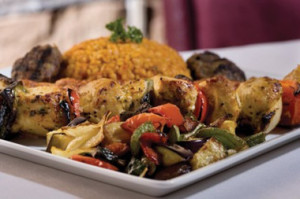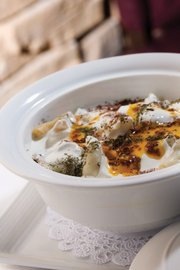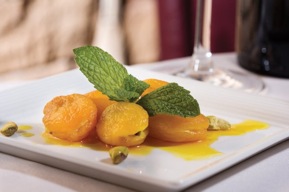Las Vegas Weekly
Turkish delight
Ibo fills a much-needed niche in Vegas’ food scene
By MAX JACOBSON
 I’ve been reviewing restaurants since 1984, and if one great cuisine has been sorely absent from my columns, it is the glorious cooking of Turkey. The reasons why Turkish restaurants are scarce in this country are complicated, so let’s just say it is the one great world cuisine missing on the American landscape, unless you happen to be in New York.
I’ve been reviewing restaurants since 1984, and if one great cuisine has been sorely absent from my columns, it is the glorious cooking of Turkey. The reasons why Turkish restaurants are scarce in this country are complicated, so let’s just say it is the one great world cuisine missing on the American landscape, unless you happen to be in New York.
That’s why Ibo, the first bona fide Turkish restaurant in Las Vegas, feels like a bolt from the blue. Ibo is Ibo Olmeztoprak (don’t even think of trying to pronounce his last name), a hotel and restaurant professional with more than 30 years of Strip experience. The chef is a charming Turkish grandmother, Selmin Takmakli, who, before this opportunity presented itself, was working as a banquet chef at the Red Rock resort.
But this is no mom-and-pop operation. It is, rather, a grandly elegant, upscale dining room and bar, with red velvet curtains, abundant stonework and an open kitchen that Ibo enclosed with opaque glass to shut out ambient noise and give his place a more romantic atmosphere. The tables of choice are clamshell booths upholstered with dark red leather. Overhead, soft light filters down from tortoiseshell chandeliers.

Suggested dishes:
imam bayildi, $8.95;
manti, $8.95;
stuffed vegetable platter, $16.95;
crème fraiche, $6.95.
So what is Turkish cuisine? Greek cuisine—forgive me, my Greek brothers—is a humble version of food cooked for Turkish pashas in the royal courts of the Ottoman Empire. The names of many familiar Greek dishes—dolmas, moussaka, baklava—in fact all have their roots in the Turkish language. I like Greek food as much as the next guy; matter of fact, I was a cook in a Greek restaurant in college. But what you get at Ibo is simply at another level.
I came in one quiet Friday evening recently, and was promptly ensconced in a booth by a portrait of none other than Ataturk, aka Mustapha Kemal, whose name means “father of the Turks.” This is vaguely comparable to eating in a pre-revolutionary roadside tavern in Delaware, where a lithograph of George Washington stares down at you from a fireplace.
You might think you haven’t eaten Turkish food before, but chances are you’ve had one or two of the mezeler, or cold appetizers, before. (The Greek and Arabic words “meze” and “mezze” are also taken from Turkish.) The most colorfully named is imam bayildi. It’s simplicity itself, delicate sautéed baby eggplant, stuffed with a tomato, onion and herb filling. But it’s nearly impossible to make unless you have the skill of Chef Selmin.
Hot appetizers are even more stunning. No Turkish restaurant in America that I know of has manti, thumbnail-sized, beef-filled dumplings served in a bowl drenched in garlic, yogurt, butter, mint and dried sumac berry, except this one. Think of hand-made ravioli and how hard they are to find. Now picture having to make seven times as many of them.
Mucver is a pancake flecked with dill and zucchini smeared with thick yogurt.
The chef’s sigara borek, golden, crispy fried pastry cigars filled with aged Gruyere, are a dream come true. Expect to fight over them the second they arrive.
Much as I hate to fill up on soup, I’ll never come back here without ordering a bowl of tavuk corbasi, a hearty chicken soup stocked with orzo pasta. It’s the best chicken soup in the city, and one of the very best I’ve tasted anywhere.

Main courses include, of course, several meaty kebabs, the flame-broiled Turkish delights that are that country’s best-known contribution to world cuisine. If that’s your bag, try karisik izgara, or mixed grill, and you’ll get lamb chops, chicken, chicken Adana (ground chicken laced with cayenne pepper) and kasseri cheese kofte (balls) on one plate.
But personally, I’d opt for kuzu incik, meltingly tender baby lamb shank, or better yet, the stuffed vegetable platter, four grape leaves, two bell peppers, an eggplant and a zucchini, stuffed with an irresistible meat-rice mixture, with a Turkish name as long as your arm.
Ibo’s creme fraiche
By all means save room for dessert. What they call crème fraîche on this menu is the delicacy stuffed apricots, poached in their own syrup and filled with a dense, rich pastry cream laced with pistachio nuts. Turkish-style baklava comes in four small squares, drier and nuttier than their Greek counterparts. And wash down that kazandibi, a Turkish cream pudding, with Turkish coffee.
Try not to ask for Greek coffee.
